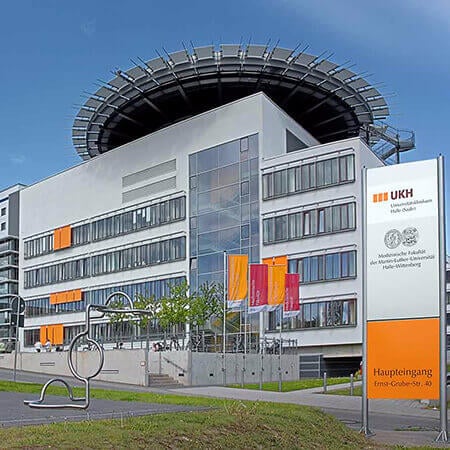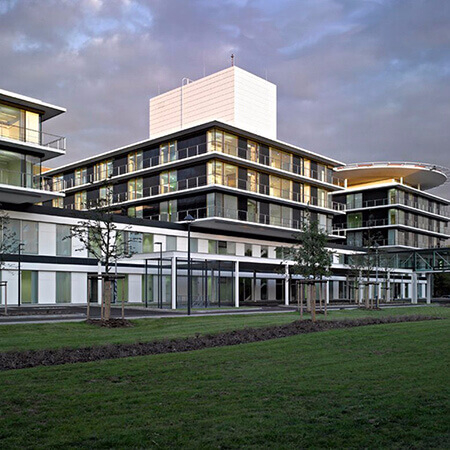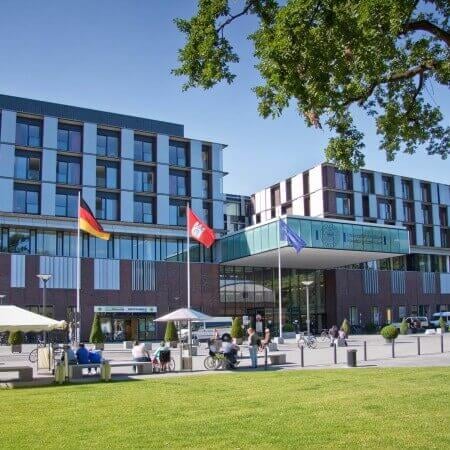Fallot's tetralogy
Due to the difficulties associated with the organization of treatment in Turkey, Switzerland, South Korea and India, we are not currently processing requests to these regions.
If you are interested in treatment in Germany, please leave a request and our specialists will contact you as soon as possible.
Fallot’s tetralogy is a congenital heart disease with severe hemodynamic disorders (abnormal blood flow through the heart and blood vessels). It consists of four anatomical components, such as:
- Displacement of the aorta into the right ventricle for more than 50%
- Stenosis (constriction) of the pulmonary artery
- Defect of the interventricular septum
- Hypertrophy (thickening of the wall) of the right ventricle
The Booking Health portal presents 22 German clinics specializing in Fallot's tetralogy treatment
Show all clinics
Fallot’s tetralogy – Diagnostics
ECG and echocardiogram are the basis of the diagnostics. Electrocardiography and physical examination of a child helps only to suspect a diagnosis. It is established after echocardiography (ultrasound of the heart).
With the help of ultrasound, the doctor sees the following issues:
- Aortic expansion and its displacement to the right
- The location of the aorta above the high defect of the interventricular septum
- Narrowing of the pulmonary arteries
- Thickening of the wall of the right ventricle and widening of its cavity
- Underdevelopment of pulmonary arteries and their branches
Best clinics for the Fallot’s tetralogy diagnostics in Germany:
Fallot’s tetralogy – Treatment
Drug therapy is only prescribed to support patient’s life and relieve hypoxic episodes. Surgery is the main treatment technique. In the most hospitals, a radical intervention is performed at the age form 6 months to 3 years. Until the moment of surgery, it is possible to perform a palliative treatments aimed at the patient’s life maintenance, but they don’t compensate the defect completely.
Radical treatment is required in the early age, normally from 3 to 6 months old or even earlier. This is necessary to prevent the compression of the tracheobronchial tree and to ensure the normal development of the respiratory tract.
Surgery before 3 months from birth is indicated if:
- There is a dependence on intravenous injection of prostaglandins in patients with pulmonary atresia
- There is a progressive cyanosis during a few weeks after birth
- Oxygen saturation of blood is less than 80%
- There are hypoxic crises
A surgeon closes the defect of the interventricular septum and eliminates the stenosis of the pulmonary artery.
A patient must do regular check-ups every 6 to 12 months after the surgery and recovery.
The risk of bacterial endocarditis remains high. Prevention of this disease is performed lifelong, if indicated clinically. The essence of prophylaxis is the prescription of antibiotics for any invasive manipulation, including dental ones.
Best clinics for the Fallot’s tetralogy treatment in Germany:

University Hospital Halle (Saale)
40111.05

University Hospital Duesseldorf
45324.78

University Hospital Hamburg-Eppendorf
52733.01
Fallot’s tetralogy – Rehabilitation
Cardiological rehabilitation improves the quality of life in patients with cardiovascular diseases. It increases the effectiveness of maintenance treatment in the case of chronic cardiovascular diseases, and also facilitates recovery after exacerbations. Rehabilitation is extremely important in case of cardiosurgical interventions.
Cardiological rehabilitation has the following aims:
- Restoration of heart muscle normal function
- Elimination of symptoms (for example, chest pain, dyspnea, etc.)
- Improving working capacity and providing patient with the opportunity to return to previous professional activities
- Improving physical stamina
- Prevention of exacerbations (including elimination of the risk factors)
- Consulting the patient on self-control and basic principles of self-help
- Improving patient's mental state, ability to "live with the disease"
Effective cardiological rehabilitation is performed only in countries with the developed medicine, as innovative medications, appropriate medical equipment and qualified healthcare professionals are available only there. Basic methods of cardiological rehabilitation include:
- Drug support for normalization of blood pressure, blood clotting, cholesterol level
- Dosed physical exercises under the supervision of an instructor, with a gradual increase in intensity
- Physiotherapy (darsonvalization, electrophoresis with medications, electrosleep, laser and magnetotherapy)
- Relaxing techniques (massage, aromatherapy, acupuncture, psychotherapy)
- Dietotherapy (control of salt and liquid amount, using spices, etc.)
- Modification of lifestyle (smoking cessation, body weight normalization)
In Germany, cardiological rehabilitation undergoes under the constant control of cardiologists, therapists and rehabilitation specialists. Programs are designed for 2 weeks. If necessary, they can last much longer. In this country, the patient is provided with qualitative care, accommodation in comfortable rooms and individually selected meals.
Rehabilitation programs in Germany show one of the best results in the world. Most patients successfully restore their working capacity and excellent health there. They remain physically active, return to the full social and family life.
Author:
The article was edited by medical expert, board certified Dr. Nadezhda Ivanisova. For the treatment of the conditions referred to in the article you must consult a doctor; the information in the article is not intended for self-medication!
Sources:
ECR - European Cardiology Review
The cost of services includes
Here you can find the cost of treatment for this disease at the German University Hospitals. Leave a request and we will provide a free consultation with a doctor and will start organizing the whole treatment process.
The program includes the following:
- Issuing of an invitation for getting a visa for treatment as quick as possible
- Fixing an appointment at a time convenient for you
- Preliminary organization of a comprehensive examination and discussion of the forthcoming treatment plan
- Arranging transfer from the airport to the hospital and back to the airport
- Provision of interpreting services and services of a personal medical coordinator
- If necessary, assistance in the organization of further surgical treatment
- Provision of a medical insurance against treatment complications covering up to 200,000 euro
- Preparation and translation of medical records and recommendations from the hospital
- Assistance in the subsequent communication with your attending physician, including consultations on repeated X-ray images through the unique medical document management system E-doc

